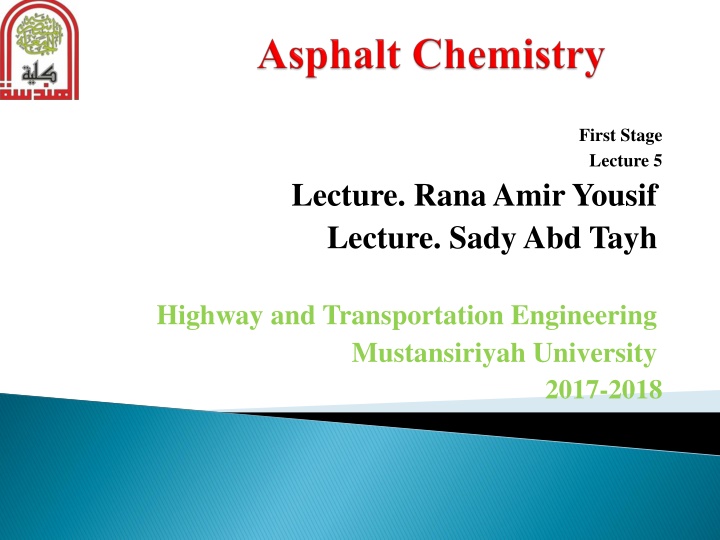
Highway and Transportation Engineering: Asphalt Chemistry Analysis Techniques
Explore the innovative techniques used in asphalt chemistry analysis, including High-Pressure Liquid Chromatography (HPLC) and Size Exclusion Chromatography (SEC), to understand asphalt composition and its impact on pavement performance.
Download Presentation

Please find below an Image/Link to download the presentation.
The content on the website is provided AS IS for your information and personal use only. It may not be sold, licensed, or shared on other websites without obtaining consent from the author. If you encounter any issues during the download, it is possible that the publisher has removed the file from their server.
You are allowed to download the files provided on this website for personal or commercial use, subject to the condition that they are used lawfully. All files are the property of their respective owners.
The content on the website is provided AS IS for your information and personal use only. It may not be sold, licensed, or shared on other websites without obtaining consent from the author.
E N D
Presentation Transcript
First Stage Lecture 5 Lecture. Rana Amir Yousif Lecture. SadyAbd Tayh Highway and Transportation Engineering Mustansiriyah University 2017-2018
References: Edwin J. Barth. Asphalt Science and Technology , 1st Ed. ,1962. James Speight Asphalt Materials Science and Technology , 1st Edition 2015.
Preparation ofAlkanes Alkyl Group is words of Alkanes removed from it hydrogen
High pressure liquid chromatography (HPLC), or high pressure gel permeation chromatography (HP- GPC), has been used to determine the molecular size distribution in asphalt cement. It is analogous to gradation (or sieve analysis) of mineral aggregates. A chromatogram of the relative amounts of large, medium, and small molecules in an asphalt cement is obtained by this procedure. Essentially, a solution of asphalt cement (tetrahydrofuran or THF has been used as solvent) is passed through gel permeation columns. The system permits largest molecules to pass quickly through the columns but successively retards the progress of the smaller molecules. A detector and recorder produces a chromatogram showing the relative amounts of molecules being eluted at different times. LMS: eluted during the first third of the elusion period as large molecular size,
MMS: eluted during the second third of the period as medium molecular size, SMS: eluted during the final third of the period as small molecular size. Greater relative amounts of LMS are associated with poor performance. This technique has the potential of characterizing the strongly associating molecular components that play a major role in determining the rheological properties and aging characteristics of asphalt cement related to pavement performance.
Advances in analytical technology were used in SHRP to better understand the asphalt chemistry. Size exclusion chromatography (SEC) was used to isolate two fractions (called SEC I and SEC II) from the asphalts. SEC I was believed to contain "associated molecules" and SEC II was believed to contain "solvent molecules". the majority of the polar materials were present in SEC I, while the nonpolar materials were in the SEC II. Increased amounts of SEC I generally caused brittleness, low temperature cracking, and fatigue cracking (thin HMApavements). Increased amounts of SEC II caused rutting and fatigue cracking (thick HMApavements).






















